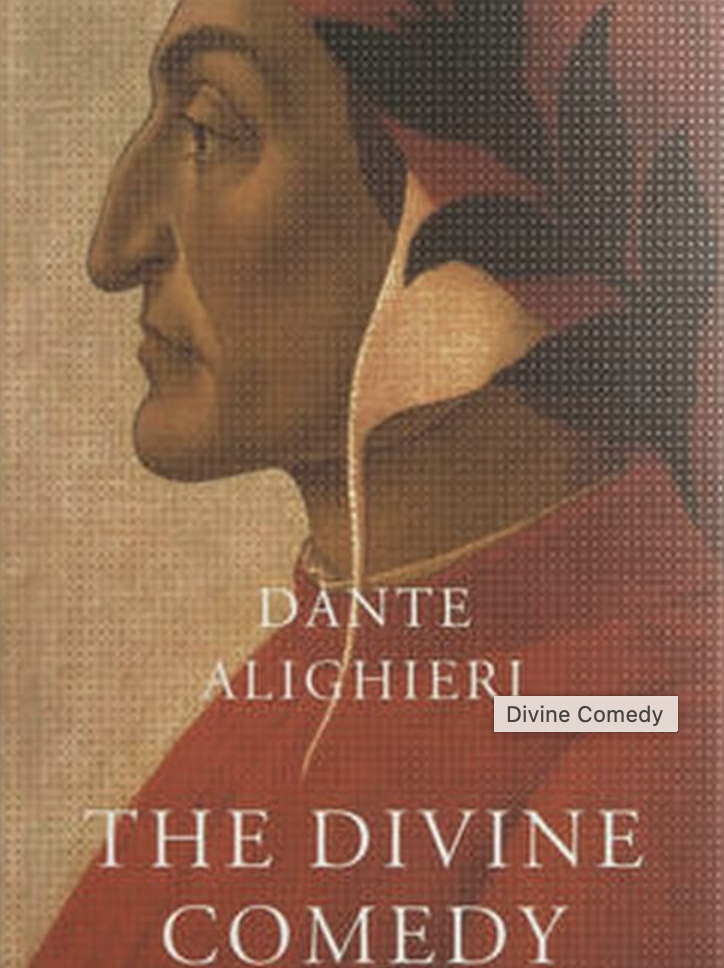
The Divine Comedy by Dante Alighieri
Theodoros Kafantaris
Published on November 23, 2025
1. Introduction
Few books in world literature dare to lead readers through Hell, climb a mountain of spiritual purification, and end with a vision of divine love—all in one sweeping narrative poem. Dante Alighieri’s The Divine Comedy does exactly that. Written in the early 14th century, this epic masterpiece is more than a journey through the afterlife: it is a meditation on morality, justice, human frailty, and the search for meaning.
What makes it so significant? For centuries, The Divine Comedy has shaped Western literary tradition, inspired countless artists, and given us some of the most enduring imagery in culture—fiery infernos, poetic justice, and circles of punishment that schoolchildren still whisper about. Dante didn’t just write a story; he built an imaginative universe that continues to echo in religion, art, psychology, and modern storytelling.
2. About the Author
Dante Alighieri (1265–1321) was a Florentine poet, philosopher, and political exile whose life was as dramatic as anything he penned. Known primarily for The Divine Comedy, he also wrote La Vita Nuova, a collection blending poetry and prose that details his idealized love for Beatrice Portinari—who later becomes a guiding force in the Comedy.
Dante lived during a turbulent period in Florence, where political factions (the Guelphs and Ghibellines) constantly struggled for control. His own political involvement resulted in exile, a personal tragedy that deeply colored his writing. Fun facts? Dante was, essentially, the original literary roaster—many of his political enemies end up suffering creative punishments in his Inferno. Subtle he was not.
His style blends classical inspiration (hello, Virgil) with Christian theology, philosophical inquiry, and sharp observations of human behavior. The result: a work that feels universal, timeless, and surprisingly modern.
3. Story Overview
a. Descent Into Darkness: Inferno
The journey begins in a dark forest, symbolic of confusion and moral crisis. Dante, playing both narrator and character, finds himself lost and threatened by three beasts. Enter Virgil, the great Roman poet, who has been sent by Beatrice to guide him through Hell.
The Inferno is structured in nine circles, each reserved for a specific sin—lust, gluttony, fraud, treachery, and so on. Through these grim layers, Dante encounters mythological figures, historical personalities, and even some of his own contemporaries (again, never cross a poet).
What stands out is Dante’s imaginative depiction of “contrapasso”—the idea that the punishment mirrors the sin. It’s poetic justice at its most literal and chilling.
b. Climbing Toward Purification: Purgatorio
After exiting Hell, Dante and Virgil ascend Mount Purgatory—yes, literally a mountain—where souls undergo purification before entering Heaven. The mood shifts dramatically from despair to hope.
Purgatory is divided into terraces where souls confront the source of their sins, not through torment but through reflection and spiritual cleansing. Here the narrative becomes gentler, more introspective, and often quite beautiful. Dante highlights themes of forgiveness, transformation, and the slow, sometimes painful, journey toward self-awareness.
This segment also dives into philosophical discussions and moral commentary, bridging earthly life with the promise of redemption.
c. The Ascent to Pure Light: Paradiso
With Virgil stepping aside, Beatrice becomes Dante’s guide into Heaven—a realm of increasing brightness, harmony, and profound spiritual insight. Paradiso is the most abstract of the three sections, filled with theological symbolism, celestial spheres, and soul-elevating reflections.
Instead of dramatic punishments or confessions, readers encounter spiritual joy, communal love, and the culmination of Dante’s quest: a vision of divine unity that transcends language itself. At its heart, Paradiso challenges the reader to imagine grace and order beyond human experience.
4. Key Takeaways
-
The power of moral imagination: Dante uses vivid storytelling to explore ethical questions that readers still grapple with today.
-
Personal growth requires confronting the self: The three realms mirror stages of self-examination—recognition, transformation, and transcendence.
-
Art as a path to meaning: Dante blends philosophy, faith, and poetry to contend that beauty and truth can guide us through confusion.
-
Forgiveness and redemption are possible: Purgatorio, in particular, reminds us that spiritual progress is gradual but attainable.
-
Love as a shaping force: From Beatrice to the divine presence, love is depicted not as sentimentality but as a cosmic force driving human purpose.
5. Why The Divine Comedy Is a Must Read
Dante’s Divine Comedy earns its place in the “100 Books You Must Read” list because it expands the imagination, deepens our understanding of human nature, and offers a poetic map of the soul’s journey. Its influence on literature, theology, psychology, visual art, and even pop culture is immense. Whether read as a philosophical exploration, a spiritual allegory, or an epic adventure, it remains one of the most enduring achievements of Western literature. Few works invite readers to reflect on their own lives with such intensity—and even fewer do it with such beauty.

